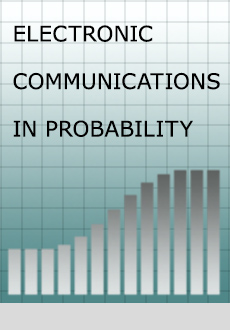Abstract
In the standard nearest-neighbor coarsening model with state space $\{-1,+1\}^{\mathbb{Z} ^2}$ and initial state chosen from symmetric product measure, it is known (see [2]) that almost surely, every vertex flips infinitely often. In this paper, we study the modified model in which a single vertex is frozen to $+1$ for all time, and show that every other site still flips infinitely often. The proof combines stochastic domination (attractivity) and influence propagation arguments.
Citation
Michael Damron. Hana Kogan. Charles M. Newman. Vladas Sidoravicius. "Coarsening with a frozen vertex." Electron. Commun. Probab. 21 1 - 4, 2016. https://doi.org/10.1214/16-ECP4785
Information





